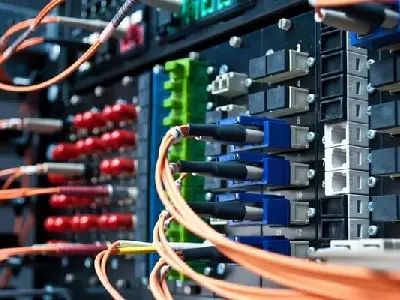Home > Fiber Optic Network
Home / Fiber Optic Network

A Fiber Optic Network is a high-speed data transmission system that uses optical fibers, which are thin strands of glass or plastic, to transmit data as pulses of light over long distances. Fiber optic networks are widely used for telecommunications, internet connectivity, and data transmission due to their many advantages over traditional copper-based networks. Here are key components and features of fiber optic networks:
A Fiber Optic Network is a high-speed data transmission system that uses optical fibers, which are thin strands of glass or plastic, to transmit data as pulses of light over long distances. Fiber optic networks are widely used for telecommunications, internet connectivity, and data transmission due to their many advantages over traditional copper-based networks. Here are key components and features of fiber optic networks:
Optical Fiber: Optical fibers are the core component of a fiber optic network. They are made of glass or plastic and have the unique property of being able to transmit data over long distances in the form of light pulses. The two primary types of optical fibers are single-mode and multi-mode:
- Single-Mode Fiber: Designed for long-distance transmission, it allows only a single mode or path of light to propagate through the core.
- Multi-Mode Fiber: Suitable for shorter distances, it permits multiple modes or paths of light to travel through the core.
Light Sources: Fiber optic networks use various light sources to generate the light pulses that travel through the optical fibers. Common light sources include light-emitting diodes (LEDs) for short-distance and lower-cost applications, and laser diodes for high-speed and long-distance transmission.
Optical Transmitters: Optical transmitters are devices that convert electrical signals into optical signals (light pulses) for transmission over the optical fibers. They play a crucial role in encoding data onto the light signal.
Optical Receivers: Optical receivers are devices that receive the incoming optical signals, convert them back into electrical signals, and decode the data. Receivers are sensitive to light and often use photodiodes or photodetectors.
Optical Amplifiers: Optical amplifiers are used to boost the strength of the optical signal as it travels long distances through the optical fiber. Erbium-doped fiber amplifiers (EDFAs) are commonly used for this purpose.
Optical Switches: Optical switches enable the redirection of optical signals to different paths or destinations within the network. They are used for network redundancy and flexibility.
Optical Splitters and Couplers: These devices are used to split or combine optical signals in the network, allowing multiple data streams to be transmitted over a single optical fiber.
Wavelength Division Multiplexing (WDM): WDM technology allows multiple data streams to be transmitted simultaneously over a single optical fiber using different wavelengths of light. This greatly increases the capacity of fiber optic networks.
Fiber Optic Cables: Fiber optic cables are used to protect and transmit the optical fibers. These cables are designed to be lightweight, durable, and capable of withstanding environmental factors like moisture and temperature changes.
Fiber Optic Connectors and Patch Panels: Connectors are used to join optical fibers together or connect them to network equipment. Patch panels are used to organize and manage these connections.
